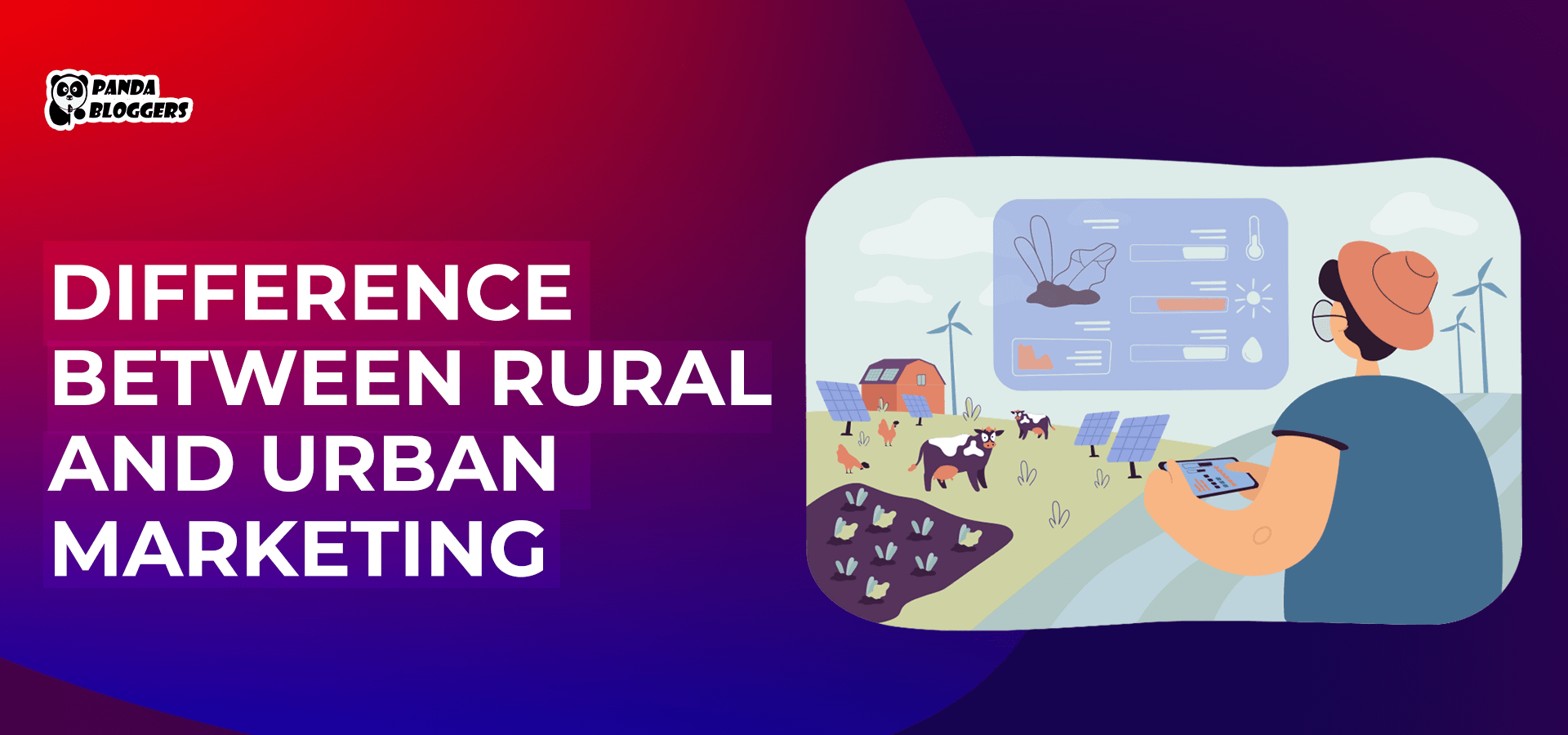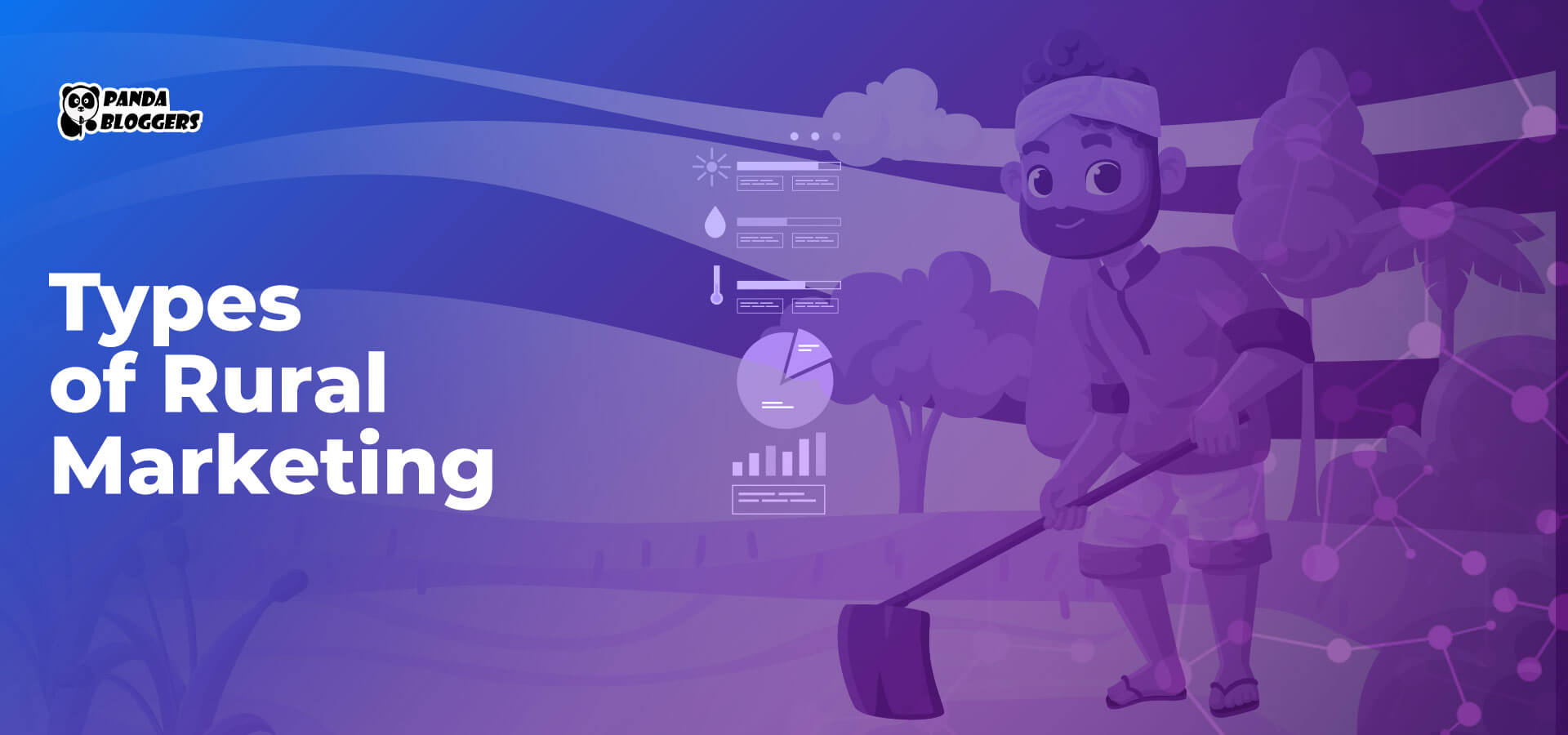 Difference between Rural and Urban Marketing
Difference between Rural and Urban Marketing
While developing, pricing, and promoting products/services, enterprises reach out to consumers living in different environments. Some of these consumers live in urban centers and consume high-end products and services. At the same time, some of these consumers live in rural centers and buy fast-moving consumer goods and durables. The rate of urbanization and industrialization varies across countries. In several countries, a larger percentage of consumers live in rural markets than in urban markets. Hence, most businesses these days consider both rural and urban markets while planning marketing and promotional campaigns. Decision-makers increase sales revenue by implementing rural and urban tactics simultaneously. Also, they explore ways to overcome the difference between rural and urban marketing. We are helping you bridge the gap between rural and urban marketing by discussing some of these key differences.
What is the Difference Between Rural and Urban Areas
When comparing rural and urban areas, several key differences emerge that shape the lives of their inhabitants. Urban regions are typically characterized by high population density, advanced infrastructure, and a fast-paced lifestyle. Cities are hubs of commerce and industry, offering diverse job opportunities, modern amenities, and efficient public transportation. This concentration of resources creates a dynamic environment where technological advancements and cultural diversity flourish.
In contrast, rural areas tend to have a sparser population and a slower, community-focused way of life. These regions often rely on agriculture and local trades as primary economic drivers. The pace of life is more relaxed, and social structures are built around tight-knit communities and longstanding traditions. Although rural areas may lack some of the infrastructural benefits found in urban centers, they offer a deep sense of community and cultural continuity that is often absent in the hustle and bustle of city life.
Another significant difference lies in accessibility and connectivity. Urban dwellers benefit from widespread internet access, modern healthcare facilities, and a variety of educational institutions, which facilitate a more connected and resource-rich lifestyle. Meanwhile, rural areas, despite facing challenges in terms of connectivity and infrastructure, are increasingly experiencing improvements thanks to government initiatives and digital innovation. This gradual shift is beginning to bridge the gap, yet the fundamental differences in lifestyle and economic activities remain distinct.
Understanding these differences is crucial not only for public policy and economic development but also for designing targeted marketing strategies. Brands and marketers must tailor their approach to resonate with the unique values, needs, and behaviors of each demographic. While urban marketing might focus on convenience, modernity, and trendiness, rural marketing should emphasize community trust, tradition, and the gradual integration of modern technologies into everyday life.
Rural Marketing
Rural marketing refers to the tactics and strategies enterprises implement to reach consumers living in various villages and hamlets. The consumers living in rural economies earn revenue by engaging primarily in agricultural activities. Also, literacy and income levels are lower in most rural markets.
Enterprises engage and influence rural consumers by focusing on four important factors – acceptability, affordability, availability, and awareness. Their marketing strategies focus on making products according to the needs, preferences, and desires of rural consumers. Also, they set prices that will make the product accessible to consumers with seasonal income. Here are various types of Rural marketing and their importance.
They explore ways to make the product available in villages and hamlets with different levels of infrastructural facilities. Finally, they make rural consumers aware of the product using conventional and digital marketing channels. Hence, enterprises often divide rural markets into multiple segments and implement strategies for individual segments.
Urban Marketing
Urban marketing refers to the tactics and strategies companies implement to reach consumers living fast-paced lives in towns and cities. While planning urban marketing campaigns, decision-makers do not have to focus on overcoming constraints like accessibility, affordability, and availability.
The tech-savvy nature of urban consumers makes it easier for enterprises to launch and promote devices and gadgets powered by cutting-edge technologies. At the same time, their disposable income creates opportunities for companies to market higher-end products and services.
Instead, their strategies focus on creating brand awareness, outperforming competitors, and promoting customer loyalty. Most urban marketing strategies these days generate, nurture, and convert leads using digital marketing channels like search engines, social media, mobile marketing, and paid advertisements.
Difference between Rural and Urban Marketing
A rural market typically differs from an urban market in several aspects. Hence, decision-makers have to create brand awareness using different marketing and promotional channels. Additionally, they need to overcome several challenges to make both marketing campaigns successful. Hence, decision-makers always consider and address the key difference between rural and urban marketing.
Market Size and Demographics
Rural Marketing: Rural markets are often characterized by smaller, scattered populations. The demographic tends to include a significant proportion of farmers, laborers, and small-scale entrepreneurs. Family sizes may be larger, and community values often play a central role.
Urban Marketing: Urban areas feature densely packed populations with diverse demographics, including professionals, students, and high-income earners. Urban consumers often have varied lifestyles and preferences, shaped by exposure to global trends.
Consumer Behavior
Rural Consumers: Purchase decisions are heavily influenced by word-of-mouth, community leaders, and local traditions. Rural buyers often prioritize durability and utility over brand appeal.
Urban Consumers: Urban consumers are more brand-conscious and influenced by advertisements, social media, and peer reviews. They often seek convenience, innovation, and lifestyle-oriented products.
Media and Communication Channels
Rural Marketing: Traditional media like radio, regional newspapers, and outdoor advertising dominate. Face-to-face interactions through fairs, village meetings, and local events also play a significant role.
Urban Marketing: Digital media, television, and print advertising are widely used. Social media platforms and e-commerce channels have significant influence, especially among younger demographics.
Product Pricing and Affordability
Rural Marketing: Price sensitivity is higher in rural markets. Affordable pricing and value-for-money propositions are crucial to winning over rural consumers.
Urban Marketing: Urban consumers are willing to pay a premium for quality, convenience, and brand value. Discounts and offers still play a role, but the focus is often on product differentiation.
Distribution and Logistics
Rural Marketing: Reaching rural consumers requires robust distribution networks to cover remote areas. Challenges include poor infrastructure and limited access to transportation.
Urban Marketing: Urban markets benefit from well-developed infrastructure, making distribution more straightforward. Warehousing, same-day deliveries, and efficient supply chains are common.
Cultural Sensitivity and Customization
Rural Marketing: Products and campaigns must align with local culture and traditions. Customization to local languages and customs enhances acceptance.
Urban Marketing: While culture is still important, urban marketing leans towards cosmopolitan themes and broader appeal. Segmentation is often based on lifestyle rather than ethnicity or tradition.
Technology Adoption
Rural Marketing: Technology penetration is growing but remains limited in comparison to urban areas. Mobile phones, especially feature phones, are a primary mode of communication.
Urban Marketing: High penetration of smartphones and internet connectivity enables advanced marketing strategies such as targeted ads, influencer marketing, and app-based promotions.
Customer Lifestyle
Rural Marketing: Rural consumers lead a much more peaceful and slow-paced lifestyle. Digital penetration also is comparatively less.
Urban Marketing: Urban consumers live a faster-paced life than rural consumers. They buy new digital gadgets regularly. Also, they spend more digital time on social networking platforms. Hence, enterprises have to create different consumer profiles or buyer personals for the same product. They need to create content and design ads according to the lifestyles of buyers living in two distinct environments.
Income Streams
Rural Marketing: The income generation in rural markets remains seasonal due to dependence on agriculture. While making rural marketing strategies, decision-makers adopt differential pricing models to create demand for a product in the rural market.
Urban Marketing: Most consumers living in urban centers have a steady and reliable source of income. Hence, companies find it easier to promote and sell high-end products in urban markets.
Customer Needs and Preferences
Rural Marketing: Rural consumers often prioritize basic needs, practicality, and affordability. Products that address agricultural, household, or local community requirements are highly valued.
Urban Marketing: Urban consumers tend to look for aspirational products and services that align with their lifestyle. They value innovation, luxury, and personalization in their purchasing decisions.
Accessibility
Rural Marketing: Accessibility to markets can be limited due to underdeveloped infrastructure. Businesses often need to invest in local distributors, mobile vans, or periodic village fairs to ensure availability.
Urban Marketing: Urban areas offer easy accessibility through retail outlets, malls, and online platforms. E-commerce has further simplified access, providing urban consumers with a wide range of options at their fingertips.
Competition
Rural Marketing: Competition is often less intense but highly localized. The presence of local brands and unorganized players is significant, requiring businesses to build trust and establish strong local connections.
Urban Marketing: Urban markets are highly competitive, with a mix of domestic and international brands vying for attention. Companies must focus on differentiation and consistent brand messaging to stay ahead.
Literacy Levels
The high literacy rates make it easier for companies to engage and influence urban consumers by creating content and ads in English. However, they have to create content and ads in local languages due to low literacy levels in rural areas. Many companies plan and run multilingual marketing campaigns to create brand awareness in rural markets. Also, they influence rural consumers using themes and ideas different from urban marketing campaigns.
Changing Consumer Profiles
Rural Marketing: In recent years, rural consumers are increasingly adopting smartphones and using the internet, leading to a shift in preferences. Exposure to digital content and e-commerce is shaping a new wave of demand for branded and aspirational products.
Urban Marketing: Urban consumers, with their higher exposure to global trends and technology, continue to evolve rapidly. Personalized experiences, sustainable products, and digital-first services are key drivers in urban markets.
Several market research studies suggest a surge in smartphone and internet users in rural areas. Likewise, a large percentage of rural consumers these days spend time on social networking platforms. However, a significant percentage of rural consumers still consume content and ads using conventional marketing channels like television and newspapers.
Many enterprises these days create brand awareness and generate demand in urban markets by running organic and paid digital marketing campaigns. However, they integrate traditional and digital marketing channels to create brand awareness in rural markets. In addition to running search engine and social media marketing campaigns, they reach rural consumers by investing in television and print advertisements.

How Brands Execute Different Strategies for Rural and Urban Marketing
Marketing strategies differ significantly when targeting rural and urban consumers due to variations in purchasing power, media consumption, and accessibility. Many brands customize their campaigns, product offerings, and engagement methods based on these factors. Here are some real-world examples of how well-known brands have taken different approaches to urban and rural markets.
1. FMCG – Hindustan Unilever (HUL)
HUL, a leader in the FMCG sector, adapts its marketing strategy based on consumer behavior in different geographies.
-
Urban Marketing:
- Focus on premium brands like Dove, Lakmé, and Ponds that cater to urban consumers looking for quality and brand value.
- Digital marketing, influencer collaborations, and targeted social media ads on platforms like Instagram and YouTube.
- Availability in supermarkets, malls, and e-commerce platforms.
-
Rural Marketing:
- Small pack sizes (sachet packaging) for products like Clinic Plus shampoo and Wheel detergent, making them more affordable.
- On-ground engagement programs like ‘Khushiyon Ki Doli’ and Project Shakti, empower rural women to become direct sellers.
- Mobile vans and rural distribution channels for wider reach.
2. Telecom – Jio
Jio revolutionized mobile connectivity in both urban and rural India but with distinct approaches.
-
Urban Marketing:
- High-speed data, bundled OTT (JioTV, JioCinema) subscriptions, and advanced 5G services for tech-savvy urban users.
- Digital-first marketing campaigns with celebrities and influencers.
- Partnerships with streaming services and e-commerce platforms.
-
Rural Marketing:
- Low-cost feature phones like JioPhone, enable first-time internet users to experience 4G connectivity.
- Expansion of network infrastructure in remote areas to enhance accessibility.
- Simple and affordable prepaid plans with regional-language customer support.
3. Automobiles – Hero MotoCorp
As the largest two-wheeler manufacturer in India, Hero MotoCorp tailors its strategy to suit urban and rural consumers.
-
Urban Marketing:
- Digital advertising and showroom experiences for premium models like Hero Xpulse and Maestro Edge.
- Collaborations with biking influencers and motorsport sponsorships.
- Financing options for urban youth and working professionals.
-
Rural Marketing:
- Fuel-efficient and durable bikes like Hero Splendor and HF Deluxe are promoted through word-of-mouth marketing.
- Roadshows, on-ground promotional events, and tie-ups with local mechanics.
- Focus on after-sales service and easy financing options via rural banks and microfinance institutions.
4. E-Commerce – Amazon India
Amazon uses different strategies to engage urban and rural shoppers.
-
Urban Marketing:
- Prime Membership benefits such as free one-day delivery, access to Amazon Prime Video, and exclusive deals.
- High-ticket products like electronics, fashion, and luxury items.
- Heavy reliance on AI-driven personalized recommendations and app-based promotions.
-
Rural Marketing:
- ‘Amazon Easy Stores’ where small retailers assist rural customers in placing online orders.
- Multi-language app interface and voice search features for non-English speakers.
- Cash-on-delivery (COD) and simple return policies to build trust.
5. Banking & Financial Services – SBI
State Bank of India (SBI) caters to both urban and rural populations with distinct approaches.
-
Urban Marketing:
- Digital banking solutions like YONO SBI and mobile banking apps for tech-savvy customers.
- Premium banking services like wealth management and investment advisory.
- Advertisements in financial newspapers and online portals.
-
Rural Marketing:
- ‘Bank Mitra’ initiative where agents help rural customers with banking transactions.
- No-frills accounts and micro-loans for small-scale entrepreneurs and farmers.
- Financial literacy campaigns in villages to promote savings and insurance.
Rural Marketing: What Does the Future Look Like?
The future of rural marketing is poised for a dynamic transformation, driven by digital advancements and changing consumer behaviors. With increasing internet penetration and smartphone adoption, rural consumers are gaining greater access to e-commerce, digital payments, and social media platforms. Brands are leveraging vernacular content, influencer marketing, and AI-driven insights to engage with rural audiences more effectively. Additionally, government initiatives aimed at improving infrastructure and digital connectivity will further bridge the urban-rural divide. While traditional marketing methods like word-of-mouth and local events will remain relevant, integrating them with digital strategies will be the key to unlocking rural market potential in the coming years.
Conclusion
Most enterprises these days generate incremental revenue by running rural and urban marketing campaigns simultaneously. They increase demand for products or services by keeping in mind the difference between rural and urban marketing. Additionally, they prioritize marketing strategies that help them reach consumers living in rural and urban environments.









Leave a Reply